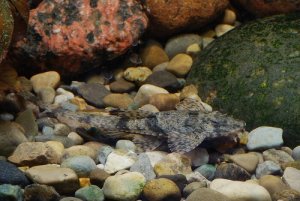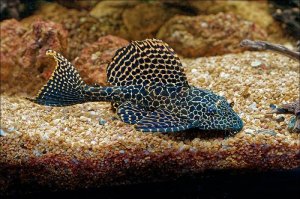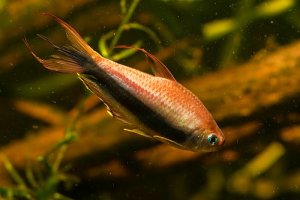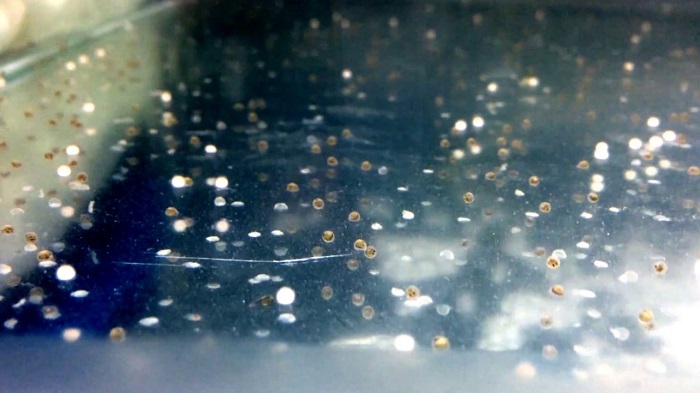
Goldfish are one of the most fascinating creatures that have enchanted many beginners, experienced aquarists and pet owners for many years. As common as they may seem in the aquarium trade, there is nothing about the Goldfish that is common or ordinary. They are intriguing, intelligent, and sociable fish that make stimulating pets for both young and old.
However, with that in mind, many individuals have delved into the notion of breeding Goldfish, whether for commercial, or personal purposes.
There are so many truths and myths regarding Goldfish breeding to be unraveled, and though they are easy enough to keep, breeding Goldfish is a more delicate process that will require time and plenty of patience, along with ample knowledge of their breeding requirements.
But firstly, it is needed to explore a bit more about the Goldfish and its requirements, before understanding breeding, and care of their eggs and hatchlings.
Goldfish Species Information
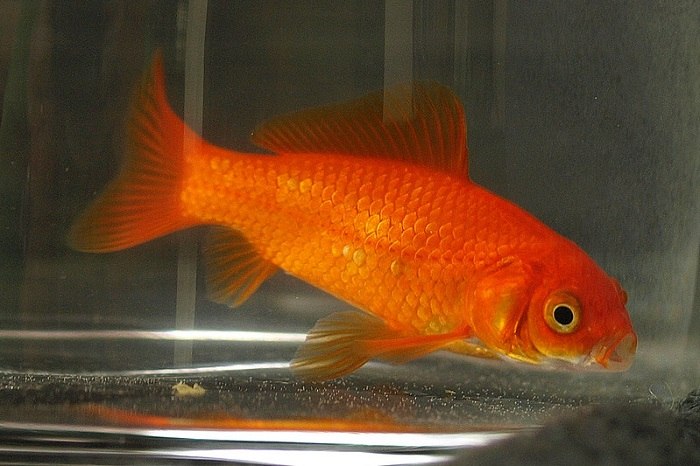
The most commonly kept freshwater aquarium species, the Goldfish, or Carassius auratus as it is known scientifically, is a species with one of the widest varieties of variant categories. As a fish from the Cyprinidae family and a small member of the Carp family, the Goldfish is native to China, though available today all over the world.
Goldfish are found in two sub-categories namely, Ornamental, or Fancy Goldfish, and the Common Goldfish.
Goldfish were initially selectively bred in China for their color, whereas eventually several more distinct breeds and colors followed.
As will be discussed in short detail further there are notable differences in Goldfish breeds regarding their size, colors, body shapes, and fin configurations.
To take a quick peek into the History of Goldfish, many different species of Carp, mostly Asian carp have been reared as feed for other fish. They are normally grey or silver, though the species showed a tendency to also produce orange, red, or yellow color mutations recorded in China.
As Goldfish became more domesticated and hybridized, more color and sub-species varieties were developed.
Did you know that the Koi and Common Carp fish species can be interbred with some Goldfish species, creating a sterile Hybrid species?
It is quite difficult to give an accurate indication of the size of a Goldfish, as there as so many different species that vary in size, however, the common wild Goldfish is known to grow between 12 cm (4.7 Inches) and 22 cm (8.7 Inches) with sizes as large as 41cm (16 inches) being documented. According to many resources, there is some dispute on the average lifespan of Goldfish, which is said to be a minimum of 5 years, and a maximum of 15 years, depending largely on the care and diet, as well as the species of Goldfish.
A few Interesting facts about Goldfish in general:
- Goldfish will grow according to the size of their environment, thus the larger their tank or pond, the larger they may grow, up to a certain size.
- The largest documented Goldfish in the world in 2008 was 48 cm (19 Inches).
- Goldfish are one of the most studied fish species in terms of their vision. They are tetrachromats, meaning they have a four-dimensional color sense and four kinds of cone cells, allowing them to differentiate between four different primary colors.
- Similarly, they are also one of the most studied fish species in terms of hearing. They have otolith hearing organs, and Weberian Ossicles connecting their swim bladder to the Otolith organs, allowing them to detect sound and sound pressure.
Types Of Goldfish And Color Variations
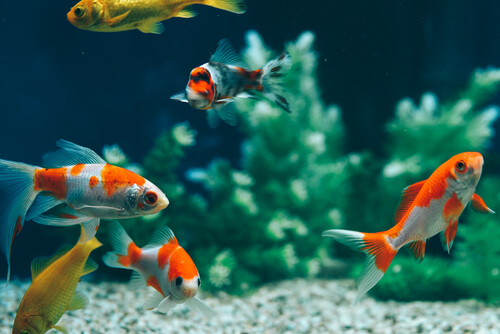
There are so many different Goldfish species in the Aquarium trade today, and so much to be said about each, though not to go too much off-topic, here is a summary of some of the Goldfish Species;
There are mainly two categories of Goldfish, as mentioned in the species section, the Common Goldfish, and Ornamental Goldfish.
Common Goldfish
Common Goldfish have a longer and more slender shaped body, with a single tail, there are three species namely;
- The Common Wild Type of Goldfish is usually in red, orange, metallic, or calico colors.
- The Comet Goldfish has more of a forked elongated Caudal fin.
- The Shubunkin Goldfish with long Finnage-like Comets, however usually Calico in color with orange, white, black, red, and blue markings.
Ornamental Or Fancy Goldfish
Most ornamental Goldfish will have a shorter and rounder body, a double tail, and longer more flowing fins. There are many species in this category;
- Veil Tails – Ryukin, Orandas, and Telescope or Globe Eye.
- Moors – Common Black Moors, Panda Moors.
- Fan Tails – Bubble-Eye Goldfish, Celestials, Pearlscales, Demekins, Eggfish, Ranchus, PomPoms, and Wakins.
However, the topic of discussion will be concentrated more on the regular Common or Comet goldfish as a species.
Quick Tips On Caring For Goldfish
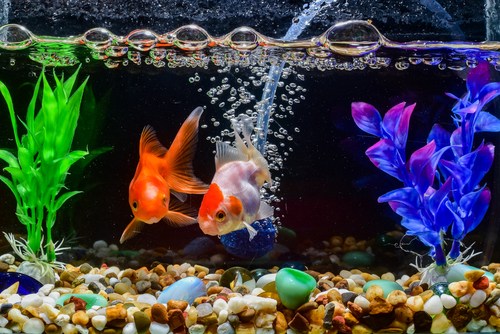
To fully comprehend Goldfish breeding and to breed healthy Goldfish it is crucial to know how to properly care for them, and keep them healthy in a suitable environment.
1. Aquarium – Firstly, Goldfish produce plenty of waste, thus proper tank maintenance is crucial, and a strong filter with moderate flow will be essential. Depending on the species of Goldfish chosen to breed a tank of around 20 or more gallons will be necessary for one or two Goldfish, and larger for more. Goldfish can live in an unheated aquarium, depending on the temperatures in your location, though with very low temperatures they may need heating. Goldfish thrive in temperatures around 65 to 75 °F (18 to 24 °C). Staying in between the pH levels of 6.5 to 8.0 is considered the best according to a variety of resources, Goldfish are reasonably tolerant within these ranges.
A medium to finer gravel or sand will make an excellent substrate choice, with a few hiding spots and toys including caves, Driftwood, Rocks, Shipwrecks, and even terracotta pots. You can select between live or synthetic plants, though Live plants offer better tank cleaning capabilities and provide oxygen. Suitable Live plants need to be robust as Goldfish may be destructive and nibble on Plants, some good choices include; Water Sprite, Anacharis, Java Ferns, Amazon swords, Water Wisteria, Cryptocoryne wendii, Bolbitis Ferns, Marimo Moss Balls.
2. Ponds – Most Goldfish species will thrive in outdoor ponds, especially in slightly warmer climates. They can survive for short periods underwater that have an iced surface, providing that there is enough oxygen in the water. Ponds will need proper filtration and regular maintenance to keep peak water conditions, some plant species and snails that are compatible may help with keeping algae under control. Though for breeding purposes, Ponds will not be in the discussion.
3. Feeding – In their natural habitat Goldfish have a diet consisting of various plant matter small crustaceans, and insects. They are known as opportunistic omnivorous feeders that tend to overeat. Overeating is detrimental to the health of Goldfish; thus it is important to adhere to a strict feeding regime.
Goldfish Pellets or flakes will mostly contain more carbohydrates than protein, thus you can supplement their diet with blood worms, brine shrimp, and other meat-based foods. Blanched vegetables such as shelled peas, and green leafy vegetables are also a particular favorite among Goldfish. Adult Goldfish involve two feedings a day which they can finish within 2 – 3 minutes, whereas fry and juveniles require a higher protein-based meal in smaller amounts, more frequently. Most Ornamental Goldfish have an irritable digestive system and tend to become constipated easily. Thus, they need food that is lower in protein, starch, and sugar especially when they get older.
4. Temperament And Personality – Though Goldfish are very sociable, friendly, and tame creatures it is important not to handle them, even if it seems irresistible. They are known to be outgoing, with some schooling behavior, and very friendly towards their species and other fish species. Keep in mind that they may become more territorial during spawning, as opposed to their generally peaceful nature.
An interesting fact is the associative learning abilities of Goldfish and their memory span of up to three months, allowing them to differentiate between different shapes colors, sound, and even their human companions. Some individuals have found their Goldfish swimming towards the glass, or surface as they approach, begging for food, and they may even learn to eat from the hand.
5. Compatible Tank Mates – You will find under strict recommendation to never keep ornamental and common Goldfish together, as ornamental Goldfish are extremely delicate in comparison to most common Goldfish species. Many Goldfish may resort to fin-nipping behavior, thus other smaller fish species with longer fins will not be ideal.
Similarly, Plecos, being nocturnal, may latch on to larger Goldfish while they sleep, devouring their slime coat and in some cases their eyes, the same can be said for Otos and Corydoras. It is best to keep Goldfish within their own family, either Common Goldfish only or ornamentals. A few other species you could consider include; Larger Snails, Platys, Giant Danios, Rosy Barbs, and Hillstream Loaches.
Common Health Concerns
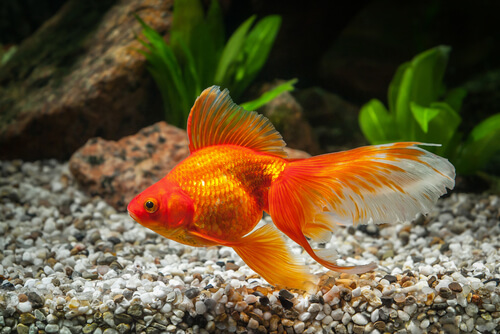
Most Common Goldfish tend to be relatively robust and healthy, given that their water conditions are kept clean and at optimal pH and temperature levels, though Ornamental Goldfish may be slightly more fragile. Mostly Goldfish are prone to common freshwater fish conditions.
- Parasites – parasites such as Ich and Trichodina, as well as Chilodonella have been noted in Goldfish. Goldfish may also contract worms or fish lice. These parasites can be treated separately by improving the environmental conditions and using chemical treatments.
- Fungal And Bacterial Infections – Goldfish may suffer from Ulcers that can become infected, especially when the slime layer on their skin is compromised. Fungal and bacterial Infections may affect the swim bladder or fins of your Goldfish. To treat ulcers 4 grams of salt and 3 grams of urea can be added per liter of water. Medication such as antibiotics may be required depending on the type of infection, and quarantine is almost always advised.
- SVC – Spring Viremia of Carp is a well-known disease affecting Goldfish and Koi alike. Most Goldfish diagnosed with the condition usually have an external parasite or bacterial infection giving rise to the virus. The condition is fatal and contagious, thus quarantine is vital, including proper cleaning and disinfecting of your aquarium. However, it must be said, that not many individuals have experienced the disease so far in general home aquariums.
Breeding Goldfish
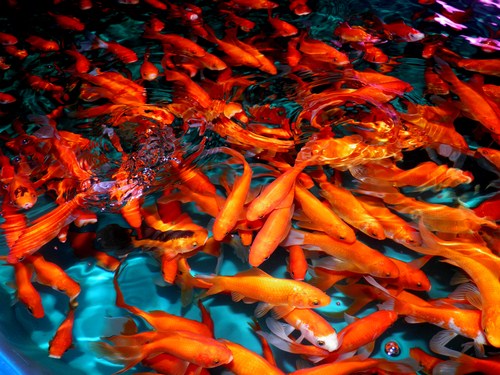
In their natural habitat breeding will usually only occur after significant temperature changes, during springtime. Goldfish require proper nutrition and a large enough living space for them to reach full maturity for breeding They are egg layers, or scatterers, with adhesive eggs that will attach to plants or spawning mops as provided. Females may lay eggs regardless of the presence of a male or not, though, without a male, the eggs remain unfertilized. There are however a few selectively bred, mostly ornamental Goldfish species that are unable to breed naturally, without human intervention, because of their more altered shape, thus artificial breeding methods known as “hand stripping” need to be performed to assist them in breeding.
- Determining Gender – Firstly before even considering breeding an adult male and female that is properly sexed will be required. Goldfish reach maturity at one year of age.
- Males – Males will develop tubercles (small, raised pimple-like growths) on the covers of their gills and their pectoral fins. Males have thinner concave vents (anal openings) in comparison to females. Males are generally thinner and more streamlined than females.
- Females – Females generally have a more rounded and convex, protruding vent (anal opening) system with no tubercles. Females have a rounder and shorter body shape than males.
Breeding Goldfish, though they are such a common and readily available fish species in the aquarium trade, is much more intricate than it sounds. A perfect environment and fertile mates are required. Attention to the details and plenty of patience will however give surprising results.
1. Create a Favourable Environment – Use a 20-gallon or larger breeding tank that you have properly sterilized. Keep in mind the Goldfish are more likely to breed during springtime and need to properly adjust to the new environment. Use proper tank décor and plants to create a more natural habitat and include bushy plants or a spawning mop.
The diet of the Goldfish needs to be changed to a more protein-based diet gradually, with smaller regular feeds. Climate changes and seasonal changes can easily be simulated by dropping the temperatures to between 10°C (50°F) and 12°C (54°F), and then raising them to between 20°C (68°F) and 23°C (74°F) when ready for breeding. Lastly, proper regular water changes will have to be done daily, replacing 205 of the water in the tank with clean-conditioned water.
2. Isolating Males and Females – After the gender of the Goldfish has been determined visually certain behavioral patterns may also tell apart males from females. Males will chase females around during the breeding season, becoming more fervent in their advances as hormones increase.
Females may show no interest in the males, unfortunately, however, the males will increase their pursuits. To create a greater desire to breed it has been advised to isolate males and females from each other for a few weeks, before breeding.
3. Breeding – Choose the ideal mates, usually the most robust and eager partners, and males with the most tubercles. The male and female can be introduced into the same tank, where the female will drop her eggs on some of the plants or provide a spawning mop, and the male will fertilize them by distributing sperm over the eggs swiftly.
It is vital to remove the male and female from the breeding tank after the eggs are fertilized, as Goldfish have cannibalistic tendencies toward their own young and eggs. The eggs may take between 4 to 7 days to hatch which will depend largely on the temperature of the water.
What Do Goldfish Eggs In Your Tank Look Like?
Across many sources, it is found that Goldfish eggs are described mostly as looking like “small round bubbles”. Fertilized Goldfish eggs will be clear, or a very light yellow color with a tiny dark spot in the center of the egg. They are very sticky and, thus will attach to a plant or spawning mop.
Female Goldfish are known to be able to lay up to 1000 eggs at once, sometimes in a single laying, or over multiple days usually a week, which depends mainly on water temperatures. You will notice that the eggs change color becoming much more see-through over a couple of days, providing that they are fertile.
The tiny black sports in the center of the eggs will become slightly more prominent in three or more days, they are the eyes of the goldfish fry (babies).
It is vital to keep the breeding tank water well oxygenated and aerated to prevent scum build up on the eggs, Methylene Blue or other water treatments can be used to achieve these results.
Water Temperatures
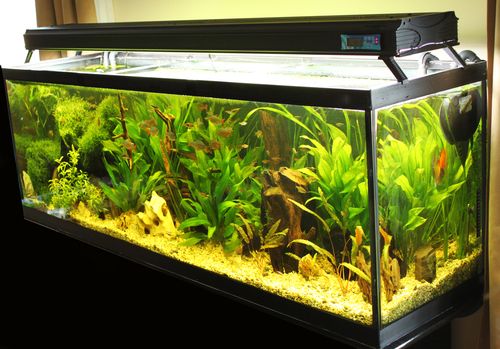
Water temperature will play a vital role in breeding, especially to increase the desire to spawn in males and females, and for the eggs to hatch in a healthy and timely condition.
- Water Temperatures for Spawning – As mentioned, Goldfish usually breed during spring, thus to simulate the season you can drop the temperatures to around 10°C (50°F) and 12°C (54°F), and after a while raise the temperatures to 20°C (68°F) and 23°C (74°F).
- Water Temperatures for Hatching – Keep your breeding tank with the eggs at a constant temperature of between 70-75oF (21-24oC), and the young fry should hatch after a few days, usually around 3 to 4 days. Colder water can slow down the period to up to 7 days before hatching.
- Water temperatures for the Fry -The Goldfish fry will thrive in the same water conditions 70-75oF (21-24oC), used for hatching eggs, and can stay in these conditions until they grow to a suitable size.
What Do Unfertilized Goldfish Eggs Look Like?
Goldfish eggs that are not fertilized will appear whiter and eventually develop a cloudy residue, in comparison to the more yellowish and transparent fertilized eggs that are clear and free from any residue.
Caring For The Fry
The small Goldfish hatchlings, referred to as fry will spend their first two to three days hanging on to a surface such as a leaf, or the sides of the tank, and will not eat at first. It is crucial to keep the tank well cycled and clean, with plenty of oxygen for them, maintaining the desired temperatures.
After around two or three days you can introduce fry food, or tiny Brine shrimp and infusoria, algae is also a good option. Be careful with filters that have strong currents that can suck up, or harm small Goldfish fry. Your young fry should be mature enough at around 6 months of age to be released into their own or communal aquarium.
Final Thoughts
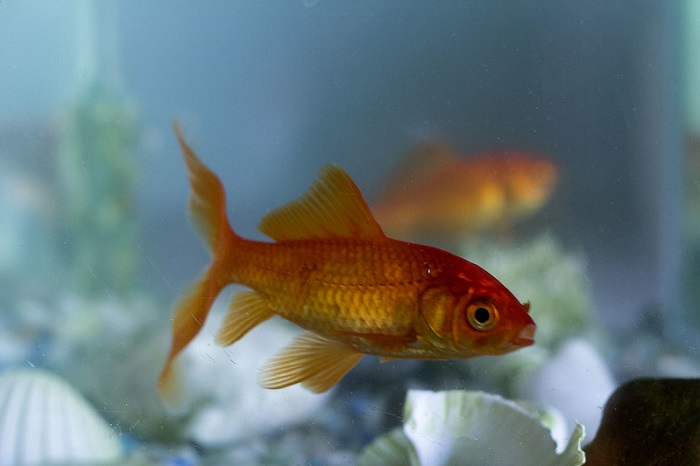
Breeding Goldfish is an intricate process that requires the right water conditions, temperatures, and selection of fertile mates. By following the proper procedures Goldfish can be bred, and young fry raised, with many rewards regarding the experience. However, keep in mind that breeding Goldfish is not an endeavor to make money, but rather a hobby for interested Aquarists. Most ornamental Goldfish may be much more difficult to breed, if so at all.


